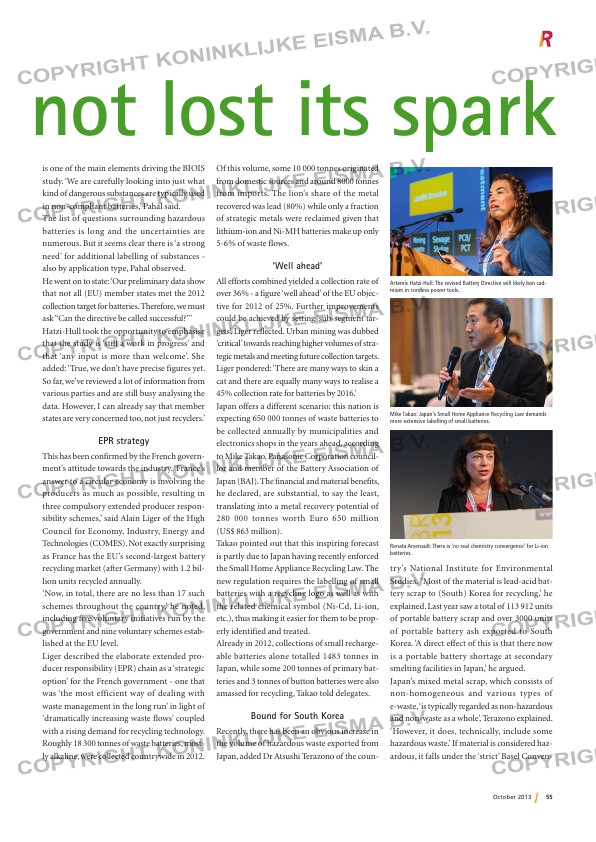Page 55 from: October 2013

55October 2013
Battery sector has not lost its spark
is one of the main elements driving the BIOIS
study. ‘We are carefully looking into just what
kind of dangerous substances are typically used
in non-compliant batteries,’ Pahal said.
The list of questions surrounding hazardous
batteries is long and the uncertainties are
numerous. But it seems clear there is ‘a strong
need’ for additional labelling of substances –
also by application type, Pahal observed.
He went on to state: ‘Our preliminary data show
that not all (EU) member states met the 2012
collection target for batteries. Therefore, we must
ask “Can the directive be called successful?”’
Hatzi-Hull took the opportunity to emphasise
that the study is ‘still a work in progress’ and
that ‘any input is more than welcome’. She
added: ‘True, we don’t have precise figures yet.
So far, we’ve reviewed a lot of information from
various parties and are still busy analysing the
data. However, I can already say that member
states are very concerned too, not just recyclers.’
EPR strategy
This has been confirmed by the French govern-
ment’s attitude towards the industry. ‘France’s
answer to a circular economy is involving the
producers as much as possible, resulting in
three compulsory extended producer respon-
sibility schemes,’ said Alain Liger of the High
Council for Economy, Industry, Energy and
Technologies (COMES). Not exactly surprising
as France has the EU’s second-largest battery
recycling market (after Germany) with 1.2 bil-
lion units recycled annually.
‘Now, in total, there are no less than 17 such
schemes throughout the country,’ he noted,
including five voluntary initiatives run by the
government and nine voluntary schemes estab-
lished at the EU level.
Liger described the elaborate extended pro-
ducer responsibility (EPR) chain as a ‘strategic
option’ for the French government – one that
was ‘the most efficient way of dealing with
waste management in the long run’ in light of
‘dramatically increasing waste flows’ coupled
with a rising demand for recycling technology.
Roughly 18 300 tonnes of waste batteries, most-
ly alkaline, were collected countrywide in 2012.
Of this volume, some 10 000 tonnes originated
from domestic sources and around 8000 tonnes
from imports. The lion’s share of the metal
recovered was lead (80%) while only a fraction
of strategic metals were reclaimed given that
lithium-ion and Ni-MH batteries make up only
5-6% of waste flows.
‘Well ahead’
All efforts combined yielded a collection rate of
over 36% – a figure ‘well ahead’ of the EU objec-
tive for 2012 of 25%. Further improvements
could be achieved by setting ‘sub-segment tar-
gets’, Liger reflected. Urban mining was dubbed
‘critical’ towards reaching higher volumes of stra-
tegic metals and meeting future collection targets.
Liger pondered: ‘There are many ways to skin a
cat and there are equally many ways to realise a
45% collection rate for batteries by 2016.’
Japan offers a different scenario: this nation is
expecting 650 000 tonnes of waste batteries to
be collected annually by municipalities and
electronics shops in the years ahead, according
to Mike Takao, Panasonic Corporation council-
lor and member of the Battery Association of
Japan (BAJ). The financial and material benefits,
he declared, are substantial, to say the least,
translating into a metal recovery potential of
280 000 tonnes worth Euro 650 million
(US$ 863 million).
Takao pointed out that this inspiring forecast
is partly due to Japan having recently enforced
the Small Home Appliance Recycling Law. The
new regulation requires the labelling of small
batteries with a recycling logo as well as with
the related chemical symbol (Ni-Cd, Li-ion,
etc.), thus making it easier for them to be prop-
erly identified and treated.
Already in 2012, collections of small recharge-
able batteries alone totalled 1483 tonnes in
Japan, while some 200 tonnes of primary bat-
teries and 3 tonnes of button batteries were also
amassed for recycling, Takao told delegates.
Bound for South Korea
Recently, there has been an obvious increase in
the volume of hazardous waste exported from
Japan, added Dr Atsushi Terazono of the coun-
try’s National Institute for Environmental
Studies. ‘Most of the material is lead-acid bat-
tery scrap to (South) Korea for recycling,’ he
explained. Last year saw a total of 113 912 units
of portable battery scrap and over 3000 units
of portable battery ash exported to South
Korea. ‘A direct effect of this is that there now
is a portable battery shortage at secondary
smelting facilities in Japan,’ he argued.
Japan’s mixed metal scrap, which consists of
non-homogeneous and various types of
e-waste, ‘is typically regarded as non-hazardous
and non-waste as a whole’, Terazono explained.
‘However, it does, technically, include some
hazardous waste.’ If material is considered haz-
ardous, it falls under the ‘strict’ Basel Conven-
Artemis Hatzi-Hull: The revised Battery Directive will likely ban cad-
mium in cordless power tools.
Mike Takao: Japan’s Small Home Appliance Recycling Law demands
more extensive labelling of small batteries.
Renata Arsenault: There is ‘no real chemistry convergence’ for Li-ion
batteries.
p00_ICBR final..indd 55 03-10-13 10:05



